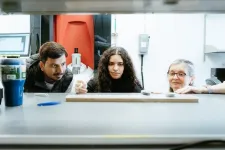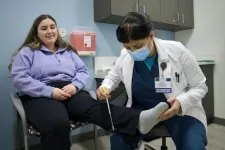(Press-News.org) In many parts of India, a single noxious pollutant from coal-fired power stations drags down annual wheat and rice yields by 10% or more, according to a new study by Stanford Doerr School of Sustainability researchers.
The two grains are critical for food security in India, the second most populous country in the world and home to a quarter of all undernourished people globally.
“We wanted to understand the impact of India’s coal electricity emissions on its agriculture because there might be real trade-offs between meeting growing electricity demand with coal generation and maintaining food security,” said Kirat Singh, a PhD student in environment and resources in the Doerr School of Sustainability and lead author of the Feb. 3 study in Proceedings of the National Academy of Sciences.
Clean air and food security
Past studies have sought to quantify overlooked costs of burning coal for electricity by estimating the number of deaths linked to resulting pollution. Government agencies and other organizations use these figures – and estimates of the economic value of statistical life – to understand the costs and benefits of various economic development strategies and environmental regulations.
Until now, however, estimates of crop damages specifically tied to coal-fired power stations – which supply more than 70% of electricity in India – have been lacking despite more than a decade of research showing that air pollutants such as ozone, sulfur dioxide, and nitrogen dioxide hurt crop yields.
“Crop productivity is incredibly important to India’s food security and economic prospects,” said senior study author David Lobell, the Benjamin M. Page Professor in the Doerr School of Sustainability’s Earth System Science Department. “We’ve known that improved air quality could help agriculture, but this study is the first to drill down to a specific sector and measure the potential benefits of reducing emissions.”
Crop damage concentrated in key regions and seasons
For the new study, the authors estimated rice and wheat crop losses linked to emissions of nitrogen dioxide, or NO2, from coal power stations. They used a statistical model that combines daily records of wind direction and electricity generation at 144 power stations in India and satellite-measured nitrogen dioxide levels over cropland.
The authors found coal power plants affected NO2 concentrations above cropland up to 100 kilometers, or roughly 62 miles, away. Eliminating coal emissions from all farmland within this range during key growing seasons (January-February and September-October) could boost the value of rice output across India by approximately $420 million per year and of wheat output by $400 million per year, according to the study.
“This study underscores the importance of looking at environmental issues under a systems lens,” said study co-author Inês Azevedo, a professor of energy science and engineering in the Doerr School of Sustainability. “Any policy focused on reducing emissions from coal power plants in India will be ignoring a crucial part of the problem if it does not consider the damages from air pollution to agriculture.”
In some states with high levels of coal-fired electricity generation, such as Chhattisgarh, coal emissions account for as much as 13-19% of the region’s nitrogen dioxide pollution, depending on the season. Elsewhere, like Uttar Pradesh, coal emissions contribute only about 3-5% of NO2 pollution. Other common sources of the gas, which results from burning fossil fuels, include vehicle exhaust and industry.
Broad benefits from emission cuts
The analysis reveals that the value of lost crop output is almost always lower than the mortality damage caused by any given coal power station. But the intensity of crop damage per gigawatt-hour of electricity generated can often be higher. At 58 of the 144 power stations studied, rice damage per gigawatt-hour exceeded mortality damage. Wheat damage per gigawatt-hour exceeded mortality damage at 35 power stations.
“It’s rare to find a single thing – in this case, reducing coal emissions – that would help agriculture so quickly and so much,” said Lobell, who is also the Gloria and Richard Kushel Director of Stanford’s Center on Food Security and the Environment.
The researchers found little overlap among the stations associated with the largest crop losses and those associated with the highest mortality. This means benefits from possible emission reductions in the future could be more significant and widely distributed than previously understood. According to the authors, the results highlight “the importance of considering crop losses alongside health impacts when regulating coal electricity emissions in India.”
“Well-targeted policies to cut emissions could deliver thousands of dollars of increased crop output for each clean gigawatt-hour, in addition to all the climate and human health benefits,” said Singh.
Lobell is also the William Wrigley Senior Fellow at the Stanford Woods Institute for the Environment and a senior fellow at the Freeman Spogli Institute (FSI) and at the Stanford Institute for Economic Policy Research (SIEPR).
Azevedo is also a professor (by courtesy) of civil and environmental engineering, a joint department of the Doerr School of Sustainability and Stanford School of Engineering. She is also a senior fellow at the Stanford Woods Institute for the Environment and at the Precourt Institute for Energy.
END
Coal emissions cost India millions in crop damages
For Indian farmland within 62 miles of a coal plant, eliminating coal emissions could add $820 million annually in wheat and rice output
2025-02-04
ELSE PRESS RELEASES FROM THIS DATE:
$10.8 million award funds USC-led clinical trial to improve hip fracture outcomes
2025-02-04
The University of Southern California has been approved for $10.8 million in research funding by the Patient-Centered Outcomes Research Institute (PCORI) to compare approaches to treating older adults with a fracture of the hip. Led by principal investigator Joseph Patterson, MD, an orthopaedic surgeon specializing in fracture care at Keck Medicine of USC, the “FASTER-Hip” trial aims to determine whether patients with a certain type of hip fracture fare better with a hip replacement or a simpler surgery known as internal fixation.
The trial leadership team includes ...
University Hospitals Cleveland Medical Center among most reputable academic medical centers
2025-02-04
CLEVELAND -- University Hospitals Cleveland Medical Center is one of the most recognizable hospitals among doctors in the U.S. and around the world, according to an annual survey.
UH Cleveland Medical Center was ranked eighth in the U.S. and 16th globally in a survey of the strongest Academic Medical Center brands, according to Brand Finance, a London-based brand valuation consultancy.
“This ranking is a reflection of all we do at University Hospitals to provide compassionate care for patients, work to find the next generation of therapies and treatments, invest ...
Emilia Morosan on team awarded Kavli Foundation grant for quantum geometry-enabled superconductivity
2025-02-04
Rice University physicist Emilia Morosan is part of an international research collaboration that has been awarded multimillion-dollar funding from The Kavli Foundation to develop and test next-generation superconductors through artificial intelligence and quantum geometry. This global initiative, spearheaded by Päivi Törmä of Aalto University in Finland, seeks to push the boundaries of quantum materials science and superconductivity.
The project includes funding from the Klaus ...
Unlock sales growth: Implement “buy now, pay later” to increase customer spending
2025-02-04
Researchers from Imperial College Business School and University of Leeds published a Journal of Marketing study that examines the impact of BNPL installment payments on retail sales. The study, forthcoming in the Journal of Marketing, is titled “Buy Now Pay Later: Impact of Installment Payments on Customer Purchases” and is authored by Stijn Maesen and Dionysius Ang.
Buy-Now-Pay-Later (BNPL) is an increasingly popular payment method, allowing customers to spread payment into interest-free installments over a few weeks or months. Worldwide ...
Research team could redefine biomedical research
2025-02-04
Professor Leslie Wolf, a Distinguished University Professor and Ben F. Johnson Jr. Chair in Law at Georgia State University College of Law, is a part of a research team that has been provided $1.9 million to conduct research designed to increase participation in biomedical studies by involving participants in the research design process. The award has been approved pending completion of a business and programmatic review by PCORI staff and issuance of a formal award contract.
Wolf, along with colleagues at the ...
Bridging a gap in carbon removal strategies
2025-02-04
Biochar: bridging a gap in carbon removal strategies
As the world works to meet net-zero carbon goals, a new study offers a critical reminder: precision matters. The researchers suggest refining how we assess a natural carbon storage strategy to ensure the technology lives up to its potential as a climate change solution.
Biochar, a charcoal-like material derived from plant biomass, has long been hailed as a promising tool for carbon dioxide removal. However, a new study by Stanford researchers highlights a critical issue: current methods for assessing biochar's carbon storage potential may significantly undervalue its true ...
Outside-in signaling shows a route into cancer cells
2025-02-04
A new study shows how an anticancer drug triggers an “outside in” signal that gets it sucked into a cancer cell. The work, published Jan. 29 in Nature Communications, reveals a new signaling mechanism that could be exploited for delivering other drugs.
Many malignant cancers overexpress a protein called P-cadherin, which is embedded in the cell membrane. Because cancer cells have a lot of P-cadherin sticking out of their surface, the protein has been targeted for drug development.
Monoclonal antibodies against P-cadherin can carry a drug payload to the cancer cells. It has not been clear, though, exactly how the antibodies attach to P-cadherin ...
NFL wives bring signature safe swim event to New Orleans
2025-02-04
NEW ORLEANS, Feb. 4, 2025 — The American Heart Association, a global force changing the future of health, is promoting water safety, a multi-market priority initiative for the Off the Field National Football League Wives Association. The American Heart Association provided Hands-Only cardiopulmonary resuscitation (CPR) and automated external defibrillator (AED) education as part of the safe swim event held at Tulane University’s Reily Center on Tuesday, Feb. 4. The event welcomed nearly ...
Pickleball program boosts health and wellness for cancer survivors, Moffitt study finds
2025-02-04
TAMPA, Fla. (Feb. 4, 2025) — A new community-based pickleball program called Project Rally is helping cancer survivors improve their physical and social well-being, according to a recent pilot study led by researchers at Moffitt Cancer Center. The program, which is offered in partnership with the YMCA of the Suncoast, has shown strong results in terms of participation, enjoyment, and physical improvements.
Staying active is a key part of cancer survivorship care and research. Physical activity can help reduce the negative effects of cancer and its treatments, while also empowering survivors to live fulfilling lives. It offers many ...
International Alzheimer’s prevention trial in young adults begins
2025-02-04
The first participants in an international clinical trial aimed at preventing Alzheimer’s disease in young adults at high risk of the disease have been enrolled. The trial, led by Washington University School of Medicine in St. Louis, aims to determine whether stopping the early molecular changes that lead to symptomatic Alzheimer’s disease can prevent the disease from ever taking hold. The study is enrolling people as young as 18 who have few or no detectable Alzheimer’s-related molecular changes in their brains, up to 25 years before the expected onset ...
LAST 30 PRESS RELEASES:
American Meteorological Society announces Rick Spinrad as 2026 President-Elect
Biomass-based carbon capture spotlighted in newly released global climate webinar recording
Illuminating invisible nano pollutants: advanced bioimaging tracks the full journey of emerging nanoscale contaminants in living systems
How does age affect recovery from spinal cord injury?
Novel AI tool offers prognosis for patients with head and neck cancer
Fathers’ microplastic exposure tied to their children’s metabolic problems
Research validates laboratory model for studying high-grade serous ovarian cancer
SIR 2026 delivers transformative breakthroughs in minimally invasive medicine to improve patient care
Stem Cell Reports most downloaded papers of 2025 highlight the breadth and impact of stem cell research
Oxford-led study estimates NHS spends around 3% of its primary and secondary care budget on the health impacts of heat and cold in England
A researcher’s long quest leads to a smart composite breakthrough
Urban wild bees act as “microbial sensors” of city health.
New study finds where you live affects recovery after a hip fracture
Forecasting the impact of fully automated vehicle adoption on US road traffic injuries
Alcohol-related hospitalizations from 2016 to 2022
Semaglutide and hospitalizations in patients with obesity and established cardiovascular disease
Researchers ‘listen in’ to embryo-mother interactions during implantation using a culture system replicating the womb lining
How changing your diet could help save the world
How to make AI truly scalable and reliable for real-time traffic assignment?
Beyond fragmented markets: A new framework for efficient and stable ride-pooling
Can shape priors make road perception more reliable for autonomous driving?
AI tracks nearly 100 years of aging research, revealing key trends and gaps
Innovative techniques enable Italy’s first imaging of individual trapped atoms
KIER successfully develops Korea-made “calibration thermoelectric module” for measuring thermoelectric device performance
Diversifying US Midwest farming for stability and resilience
Emphasizing immigrants’ deservingness shifts attitudes
Japanese eels, climate change, and river temperature
Pusan National University researchers discover faster, smarter heat treatment for lightweight magnesium metals
China’s 2024 Gastroenterology Report: marked progress in endoscopy quality and disease management
Pusan National University researchers uncover scalable method for ultrahigh-resolution quantum dot displays
[Press-News.org] Coal emissions cost India millions in crop damagesFor Indian farmland within 62 miles of a coal plant, eliminating coal emissions could add $820 million annually in wheat and rice output



